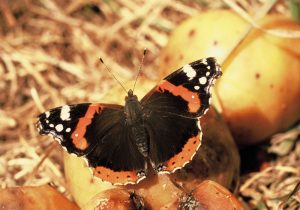Golden leaves and boozing butterflies by Andrew Cooper
Down here in deepest South Devon a damp Autumn did not seem so bad after such a mediocre end to Summer. Luckily I have the sort of memory that seems to miss out the bad bits, so will gloss over the recent gale and monsoon that turned our fields to mud. A row of rusty red beech trees decorated the valley floor nicely for several weeks and the bright golden field maple finally lost all its leaves. Winter comes late this far south. Even some butterflies were still feeding on ivy up until a few days ago. But now we have had our first frost and even a light fall of snow on the highest parts of Dartmoor, so it is beginning to feel like winter.
Wrens seem to get bolder as the season cools. Foraging through our barns and somehow even getting into the tiny church just a short walk away. But colder weather has its benefits. The first woodcock can be found in a quiet part of the farm, where a stream meanders under trees. But of all the birds we have here only one has got us well and truly trained. For several years a magnificent cock pheasant crows loudly outside the front door when hungry. In the coldest weather he will even take food from my hand. Not all birds are so trusting.
Flocks of Redwings and the first Feldfares are easily spooked in the orchard. Here windfall apples are an important source of food for so many creatures.
A few years ago we hosted BBC Autumnwatch and our badgers performed brilliantly, scrumping apples and helping themselves to the last of the blackberries right in front of camera. But for colour and ease of filming the red admiral butterfly was a star. Usually among the last on the wing the orchard is often one of the best places to get close to them. A sunny morning is when they search for fallen apples. And this is the best times to get a photograph. After few minutes imbibing the amber liquid the butterflies become a bit tipsy and so less wary. The only thing that can spoil a shot is when they over indulge and gracefully slide off the apple!
Wrens seem to get bolder as the season cools. Foraging through our barns and somehow even getting into the tiny church just a short walk away. But colder weather has its benefits. The first woodcock can be found in a quiet part of the farm, where a stream meanders under trees. But of all the birds we have here only one has got us well and truly trained. For several years a magnificent cock pheasant crows loudly outside the front door when hungry. In the coldest weather he will even take food from my hand. Not all birds are so trusting.
Flocks of Redwings and the first Feldfares are easily spooked in the orchard. Here windfall apples are an important source of food for so many creatures.
A few years ago we hosted BBC Autumnwatch and our badgers performed brilliantly, scrumping apples and helping themselves to the last of the blackberries right in front of camera. But for colour and ease of filming the red admiral butterfly was a star. Usually among the last on the wing the orchard is often one of the best places to get close to them. A sunny morning is when they search for fallen apples. And this is the best times to get a photograph. After few minutes imbibing the amber liquid the butterflies become a bit tipsy and so less wary. The only thing that can spoil a shot is when they over indulge and gracefully slide off the apple!



